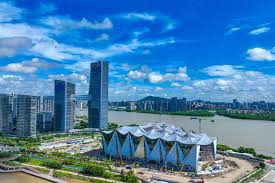By He Linping, Jiang Xiaodan, People’s Daily
At 8 a.m., Zhong Chao, founder of PAM²L Biotechnologies, a developer of innovative, low-cost, and sustainable functional biomaterials, was already busy at work in Guangming Science City, a comprehensive national science center in Guangming district, Shenzhen, south China’s Guangdong province.
Zhong, also a researcher at the Shenzhen Institute of Advanced Technology, Chinese Academy of Science, has now become a pioneering entrepreneur in the fertile “test field” of industrial innovation.
In 2019, Zhong research revealed that feeding probiotics to nematodes extended their lifespan by regulating mitochondrial function through a bacterial enzyme. “Applying this mechanism to human cells,” Zhong said, “could yield breakthrough anti-aging compounds.”
Guided by this insight, his team used synthetic biology to engineer a bacterial strain capable of mass-producing the enzyme.
Early R&D required cross-disciplinary collaboration among microbiologists and materials scientists Guangming’s integrated ecosystem – where research institutes and businesses share facilities – enabled real-time calibration of technical parameters with engineers. Within three years, laboratory discoveries advanced to mass production.
“From nematode longevity studies to commercial anti-aging ingredients and medical-grade biomaterials, this progress was made possible by the Guangdong-Hong Kong-Macao ‘innovation relay,’” Zhong emphasized. “That’s why we chose this base.”
“This base” extends beyond Guangming Science City. Northwest, the Pearl River Estuary connects Dongguan and Guangzhou; southward, it links Shenzhen and Hong Kong – forming a 100-kilometer innovation corridor.
Leveraging geographic advantages, robust resources, and the Guangdong-Hong Kong-Macao Greater Bay Area’s ongoing development as an international tech hub, the region now concentrates innovation entities and expertise, creating a dynamic synergy along the Guangzhou-Shenzhen-Hong Kong scientific innovation corridor.
In September, the World Intellectual Property Organization released the Global Innovation Index 2025, ranking the “Shenzhen–Hong Kong–Guangzhou” cluster as the world’s largest innovation hub—surpassing Japan’s “Tokyo–Yokohama” cluster for the first time.
In Guangming district, PAM²L Biotechnologies is not alone. Another company, Liying Biotech, produces recombinant collagen proteins with triple-helix structures. Many of its founding members brought cutting-edge theoretical expertise to Guangming, and after achieving breakthroughs in pilot trials, they confidently handed over industrialization to manufacturing partners “along the same corridor.”
“The Pearl River Delta offers mature precision-instrument supply chains,” a Liying representative stated, highlighting a Dongguan-made protein purification system costing 1/20 of imported equivalents while outperforming them. “This R&D-manufacturing synergy boosts our competitiveness.”
“When scientific research, industry, policy, and the market work hand in hand, ideas from the lab can quickly bear industrial fruit,” said Zhang Guangnan, a professor at the Institute of Guangdong, Hong Kong and Macao Development Studies, Sun Yat-sen University.
“What drives this is not only geographic proximity and complementary strengths, but also the free flow of innovation factors across the corridor,” Zhang added.
This summer, Signet Therapeutics drew global attention with its targeted therapy for diffuse gastric cancer. COO Dai Changgui explained: “Our AI algorithms screen billions of molecules to pinpoint tumor-weakness compounds, slashing drug development time.”
In 2020, founder Zhang Haisheng of Signet Therapeutics returned to Shenzhen from overseas with his research vision. Thanks to the Hetao Shenzhen-Hong Kong Science and Technology Innovation Cooperation Zone’s unique location and supportive policies, his team quickly grew to include over 80 percent R&D personnel, nearly 70 percent of whom hold master’s or doctoral degrees.
“This place is like a powerful magnet,” Dai noted. “International experts can easily travel between Shenzhen and Hong Kong through fast channels, while the Greater Bay Area’s well-developed industrial ecosystem doubles our experimental efficiency.”
On June 27 this year, the Greater Bay Area International Clinical Trials Center of the Shenzhen Medical Academy of Research and Translation was officially inaugurated. Focusing on building a closed-loop clinical trial ecosystem across the region, the center effectively integrates clinical research resources.
According to its director, Li Yichong, by enabling resource sharing and efficient collaboration, the center will help turn the Greater Bay Area into a major global source of biomedical innovation.
In recent years, Guangdong province has developed 26 key innovation platforms along the scientific innovation corridor. In 2024, innovation entities within these platforms accounted for about 1/10 of the province’s total PCT patent applications. Cities, parks, major facilities, and laboratories along the corridor, like pearls strung together, are shining ever more brightly as the corridor’s innovation vitality continues to surge.
Guangdong-Hong Kong-Macao Greater Bay Area sees vital scientific innovation

Leave a Reply